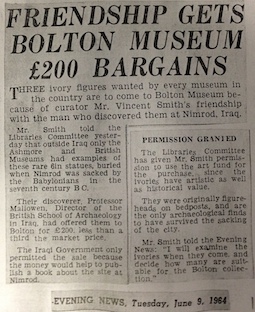The Nimrud ivories: forgotten treasures
The many thousands of beautiful ivory carvings from Nimrud have been alternately treasured and forgotten throughout their long history. Most were made by master craftsmen in the northeastern Mediterranean, then abandoned as surplus booty in the storerooms of Kalhu. Some were carved in Assyria itself and were an important element of luxury court living. In modern times, some have been plundered or forgotten again, while others are cherished as exquisite examples of ancient art.
Ebony and ivory
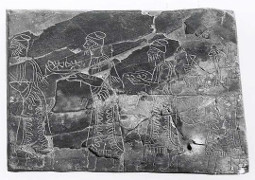
Image 1: Foreign dignitaries process with their tribute TT , on a fragment of ivory furniture carved in the Assyrian style. This piece was found in the throne room of Nabu's temple in Kalhu, burnt in the invasion of 614 BC (1). ND 4195c = MMA 57.27.2 Metropolitan Museum of Art, OASC licence. View MMA 57.27.2 on the Metropolitan Museum's website.
I received tribute TT from Ahunu PGP , a man of Bit-Adini PGP : silver TT , gold TT , tin, bronze TT , bronze cauldrons TT , ivory dishes, ivory couches, ivory chests, ivory thrones decorated with silver and gold, gold bracelets, gold rings with trimming, gold necklaces, a gold dagger, oxen, sheep, and wine (2).
I received tribute from the kings of the sea coast, from the lands of the people of Tyre PGP , Sidon PGP , Byblos PGP , Mahallatu PGP , Maizu PGP , Kaizu PGP , Amurru PGP , and the city of Arwad PGP which is (on an island) in the sea: silver, gold, tin, bronze, a bronze cauldron, linen garments with multi-coloured trim, a large female monkey, a small female monkey, ebony, boxwood, and hippopotamus ivory (3).
These two extracts from king Assurnasirpal's annals, dedicated the to the god Ninurta, recount the treasures extracted from western kingdoms in return for leaving them in peace (Image 1). Precious metals top the list, of course, but ivory objects also feature prominently, along with other exotic materials.
Likewise, Assurnasirpal's son Shalmaneser also celebrates the receipt of "silver, gold, ebony and elephant ivory" from the tribes of Babylonia PGP , on the base of his throne in Fort Shalmaneser (4), and "silver, gold, gold pails, ivory and spears" from Suhu PGP , on the Black Obelisk.
So where did this exotic material come from, why was it so highly prized by the Assyrians, and how did they use it when it got to Kalhu?
Phoenician masterworks, Assyrian imitations
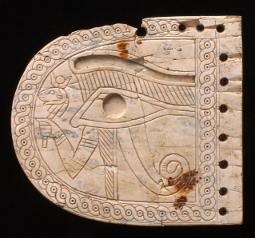
Image 2: This piece of ivory, probably part of a horse's blinker, was one of hundreds of ivory objects found in Room SW37 of Fort Shalmaneser. It was probably carved in Syria, and shows heavy Egyptian PGP influence. The holes at the edge allowed it to be sewn on to a leather harness (5). ND 10387 = Ashmolean 1962.50. © Ashmolean Museum. View object on the Ashmolean's website.
As the inscriptions suggest, the Assyrians' ivories were mostly carved by craftsmen in the little independent kingdoms along the northeastern Mediterranean coast, in the region we now call Phoenicia PGP . The ivory itself almost certainly came from Egypt PGP and its southern neighbour Nubia PGP , in the form of elephants' tusks and hippopotamus' teeth (6). Egyptian influence showed too in the style and substance of the most elegant types of carving, which typically depicted Egyptian-type pharaoahs, deities and cartouches TT (Image 3). Closely related styles have been attributed to nearby areas of northern and central Syria (Image 2) (7).
The craftsmen were, of course constrained by the physical limitations of the tusks and teeth. But as well as small objects made from single blocks of the material, they also put together large and elaborate pieces of furniture, such as chairs and beds. Tiny alphabetic marks in inconspicuous places helped fitters to assemble them, in an early form of DIY instructions. The must luxurious of these items were also inlaid with coloured glass and semi-precious stones, or highlighted with gold leaf TT . Phoenician ivories were traded all over the Middle East and Mediterranean. They have been found in excavations on Crete PGP and Cyprus PGP , as well as Etruria PGP in central Italy (8).
Equally, Assyrian craftsman developed their own local style of ivory carving, which was much less ornate (Image 1). Where Phoenician and Syrian ivory-workers favoured rounded figures, set off in relatively high relief from their backgrounds, Assyrians incised the outlines of their figures into the flat surface of the material, and did not attempt to make them three-dimensional. The images themselves were closely related to the scenes on the palace walls: battles, processions, and protective genies TT (9).
Luxury living and heaped-up hoards
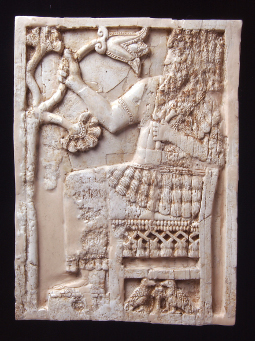
Image 3: This panel, showing a man on an elaborate throne was originally one of four that made up part of a larger piece of furniture, probably also a chair (10). It was carved in the Phoenician style and was found in Room SW7 of Fort Shalmaneser. Two of the three others are now in the British Museum, London, the third at the Metropolitan Museum, New York. ND 7908 = Ashmolean 1959.207, © Ashmolean Museum. View object on the Ashmolean's website.
Ivory furniture was all the rage amongst Assyrian royalty and the elite of their entourage at Kalhu. Even at the end the end of empire, when pillagers rampaged through the formerly secluded citadel in 612 BC, they smashed carved ivory thrones in Nabu's temple, and in the Burnt Palace PGP (Image 1). They threw huge quantities of elaborate ivory trinkets down the wells in the women's quarters of the Northwest Palace, after ripping off their gold and inlay ornamentation. Elite residences along the northeast edge of the citadel TT —known to archaeologists as the Town Wall Houses PGP —and the rab ēkalli's apartment in Fort Shalmaneser also boasted highly decorated ivory fitments and furnishings. For the most part, the furniture in the ceremonial spaces was in Assyrian style, matching the rest of the official decor, but private possessions came in all types of design, depending on the owner's personal taste (11) (12).
The vast majority of the ivory that the invaders (and, later, archaeologists) found, however, had never been used. War booty and peaceful tribute alike, whether unworked tusks or finely worked panels, had been stripped of their gold and then squirrelled away (Image 2, Image 3. Over the course of the ninth and eighth centuries Syrian and Phoenician ivory furniture components and horse trappings were piled high in Rooms V and HH in the living quarters of Northwest Palace, for instance (13), and Rooms SW 7, 11, 12 and 37 off the Southeast Courtyard of Fort Shalmaneser (14) (15) (16) (17). Maybe the intention was to re-assemble or re-work them, but in fact these vast hoards lay untouched for decades, even centuries (18).
Agatha and the ivories
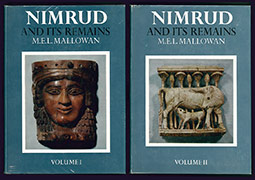
Image 4: The dust jackets of Mallowan's PGP glossy final report on Nimrud featured two of the most striking ivory objects discovered at the site. The piece gracing Volume I was popularly known as the 'Mona Lisa of Nimrud' (19). View large image.
Many different people have found caches of ivory objects at Nimrud over the past few centuries:
- From only his second day of work in 1845, Layard PGP began to find large numbers of ivory fragments in the Northwest Palace (rooms A, V & W). Loftus PGP also uncovered ivories in the Central Palace PGP and Burnt Palace PGP in the 1850s (20).
- In the 1940s and 50s, Mallowan PGP and his team also found significant quantities of ivories in the Northwest Palace (wells NN, AB, and AJ), as well as Ezida PGP and the Town Wall Houses.
- David Oates' PGP team excavated literally thousands of pieces from Fort Shalmaneser in the late 50s and early 60s.
- During Iraqi archaeological work in the Northwest Palace, Said al-Iraqi PGP discovered further ivories in Well AJ in the mid-1970s (21), while Muzahim Mahmoud PGP found yet more in a the newly excavated Well 4 (Courtyard 80) in 1992.
- Paolo Fiorina's PGP Italian team found nearly 1500 more fragments in the southwest of Fort Shalmaneser in 1987-89.
The total number of pieces amounts to more than 6000. Yet the Nimrud ivories are associated with one person above all: Max Mallowan's first wife, the famous detective novelist Agatha Christie PGP , who accompanied the BSAI TT team on excavation every year. Her contributions included registering newly-excavated finds, typing the field catalogue, taking and developing photographs of the site (22). By her own account, she also cleaned some of the ivories that the team uncovered, including the famous 'Mona Lisa' (Image 4). She describes removing the dirt from the ivories with "an orange stick, a very fine knitting needle... a dentist's tool... and a jar of cosmetic face-cream, which I found more useful than anything else for gently coaxing the dirt out of the crevices" (23). Christie was also given the painstaking task of piecing together tiny fragments of an ivory writing board TT found in Well AB.
This focus on a famous figure's feminine ingenuity served a very useful purpose at the time. Christie's glamour polished the ivories even more effectively than her face-cream. Mallowan used his wife's high profile to attract sponsors and benefactors — and was able to gift them ivories from BSAI's share of the excavation finds at the time. The mundane pot of face-cream, a staple of all British women's dressing tables and bathroom cupboards in the mid-20th century, also helped to domesticate the ivories for readers of publications like The Illustrated London News TT . They were no longer incomprehensible bits and pieces grubbed up from Iraqi soil but delicate beauties, as smooth and creamy and age-defying as the most pampered society lady's skin.
In reality, however, Christie was put in charge of only a small number of objects. As team member Joan Oates remembers, Christie's failing eyesight meant that in later seasons TT this work was better left to professionals. The younger members of staff kept the most precious pieces of ivory on the highest shelves of the dig-house TT workroom, out of harm's way. Further, the initial work to consolidate flaking, waterlogged ivories as they came out of the wet ground was only part of a long process (24). Expert diggers, mostly Iraqi men of the Sherqati tribe PGP , carefully removed the delicate objects from their findspots TT and transported them to the dig house. Then young British staff, such as Ann Searight, Olwen Brogan, and Julian Reade, cleaned and consolidated the ivories with methylated spirits TT , acetone TT and polyvinyl acetate TT (25). Once the objects reached the Iraq Museum TT or the Institute of Archaeology TT in London, experts like Anna Plowden gave them careful conservation TT treatment, sometimes over many months or years, before they went into storage or onto display (26). And, as our case study from Birmingham shows, that work often needs to be updated to ensure that the ivories remain in good condition.
The ivories today
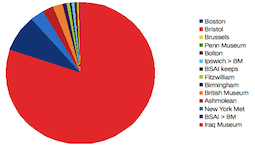
Image 5: Until Iraqi law changed in 1968, foreign excavation teams were allowed to keep some of their less spectacular finds. Most of the 430 or so pieces of ivory from Room SW12 in Fort Shalmaneser stayed in Iraq, under the Iraq Museum's safekeeping. As shown in this pie chart, some were displayed in provincial museums across Iraq. About a fifth, given to BSAI as excavators, were then distributed to a dozen or so museums and universities who had sponsored the project. View large image.
The BSAI excavation gifted objects to museums in return for financial donations towards the archaeological work. As excavations at Fort Shalmaneser continued, the ivories became highly sought after, desired by museums as examples of ancient artistic production. Although institutions had no say in what objects they would receive, they were likely to get at least some ivories given the sheer numbers being excavated.
Let us look for instance, at the 430-odd pieces of ivory found in Room SW12 of Fort Shalmaneser in 1957 and 1962-3 (Image 5) (27). In this case, the majority, some 80%, were retained by the Iraq Museum, as in 1968 a new Iraqi law stopped the practice of dividing archaeological finds TT between the state and the excavators before the final division for this dig had been made. However, before that time 85 had already been allocated to BSAI. Mallowan kept less than half of them as the School's property, dispersing the rest to its institutional backers, mostly in the UK and USA.
About a dozen ivories each went to the big three supporters: the British Museum TT in London, the Ashmolean Museum TT in Oxford, and the Metropolitan Museum of Art TT in New York. There they slotted in well to large, well established collections of ancient Near Eastern artefacts. From Nimrud itself, each museum already had Layard-era sculptures from the Northwest Palace, as well as a growing set of objects excavated and donated by BSAI. Some of the smaller regional and local museums, by contrast, ultimately struggled with the ivories they received. The two examples below explore how two responded to the challenges posed by holding a few isolated examples of Nimrud ivories, and made them relevant to today's museum audiences.
During the first half of the twentieth century, the prevailing vision was for museums to be much more universal in their collecting. In archaeology collections, museums often acquired artefacts from a broad range of geographical regions and time periods. But over the past few decades, museum collecting and display practices have changed considerably, to focus particular specialisms and strengths rather than breadth. Nowadays, isolated groups of objects with little relation to the broader collection, such as small groups of Nimrud ivories, can be difficult to integrate into gallery displays. Museums may also not have the in-house curatorial TT specialism to interpret and use these objects effectively.
Bolton's ivories as part of world cultures gallery
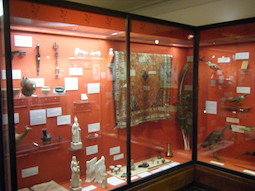
Image 7: The Nimrud ivories owned by Bolton Museum are currently displayed with a variety of other objects relating to the Middle East and India, from 19th-century porcelain replicas of Assyrian statues to peacocks' feathers and Persian carpets. There are plans to redevelop the gallery soon. Photo by Eleanor Robson, February 2014. View large image.
Bolton Museum received three Nimrud ivories from BSAI in 1964, including two from Room SW12. Curator TT Vincent Smith was a friend of Mallowan's and this personal connection helped to secure the ivories for the museum. Local newspaper The Bolton Evening News reported the acquisition under the headline "Friendship gets Bolton Museum £200 Bargains" (Image 6). The glamour of their association with Mallowan and Christie (even though they were no longer directly involved in the exavation) counted for as much as the beauty and antiquity of the ivories themselves. Personal networks, prestige and patronage played a big a role in the dispersal of the ivories, just as they had in Layard's excavations 100 years previously.
Bolton's ivories are currently displayed in its gallery of world cultures, along with other selected items from across Asia (Image 7). The collection as a whole contains approximately 4,000 varied objects, acquired though donation and purchase at various times over the decades. As the museum's website explains, their value for audiences today is in what they reveal about past collecting:
Such a small collection – although having several highlights – can not provide anything more than a random view of world cultures. It is however a valuable extension of the Social History collection in the way it shows how Bolton / Boltonians have viewed and used the wider world, and this is the focus of the current displays.
Ipswich's ivories get new home
Ipswich Museum's collections began with natural history in the mid-19th century and expanded to include archaeological material by 1900. Like Bolton, it has a large Egyptology collection, which is displayed and used for educational purposes. Conversely, the museum has only a few items from Assyria, including three ivories from BSAI's excavation, two from Room SW12. They were purchased in the 1960s for illustrating "the general history of ancient civilisations", probably for inclusion in a general world cultures gallery. In recent years though, the ivories have been in storage and Ipswich has no future plans to create a gallery in which they could be displayed.
Current museological practice encourages museums to review the collections in their care, considering what purposes they serve and how effectively they are being used to fulfil the museum's core purposes. Museums are also encouraged to consider whether their collection is in fact the most effective home for certain objects. As long as ethical guidelines are followed, objects can be considered for transfer to a more appropriate home in another museum.
Ipswich Museum conducted a review of their collection in 2012, which proposed, after ethical consideration, to transfer their three Nimrud ivories to the British Museum, where they could be better appreciated within the context of wider Nimrud collections. The transfer of the ivories was completed at the end of 2013.
The Iraq Museum ivories
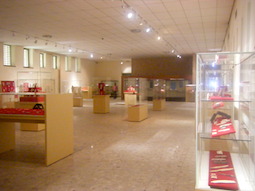
Image 8: The Iraq Museum has a large public gallery devoted to the ivories from Nimrud. Photo by Eleanor Robson, April 2013. View large image.
The ivories kept by the Iraqi authorities did not all stay in Baghdad PGP . Iraq is divided into 19 provinces TT or governorates, each with its own museum. Until recently, each of those museums displayed a similar range of artefacts, telling a unified story of the region from most ancient times to the early Islamic period. The Nimrud ivories were an important part of that story. Thus they have been vulnerable to postwar looting on three separate occasions over the past quarter-century.
Over two thousand museum objects were stolen or destroyed during the 1991 uprising after the Gulf War TT , including many ivories and other Nimrud artefacts. More famously, the Iraq Museum itself, as well as Mosul PGP and other provincial museums, were attacked after the 2003 Iraq War TT , and a bank vault flooded, waterlogging ivories and other precious antiquities. We still do not have a definitive account of what was lost. Most recently, in the summer of 2014 the jihadi group ISIS took control of much of northern Iraq around Mosul, including the site of Nimrud itself. More happily, in Baghdad the Iraq Museum is gradually recovering from the privations of the past few decades and re-opened in February 2015. A large gallery devoted to the Nimrud ivories has been refurbished for public viewing (Image 8).
BSAI-BISI's ivories
The BSAI retained ownership of many ivories for several decades. In 2011 its successor organisation, the British Institute for the Study of Iraq TT , decided that this was not in the best interests of the ivories themselves. The British Museum raised funds to buy a third of the collection, while BISI donated a further proportion to the museum in recognition of their stewardship. Thirty-six pieces from Room SW12 were included in the transfer. They are now much more accessible to researchers and museum visitors. BISI has kept the remaining portion, a choice selection of particularly fine pieces including 9 from SW12. The aim is to return them to Iraq once it is appropriate to do so. Once again, the story of Agatha Christie's face cream proved useful for generating publicity and income for the transaction.
Publication
As we have seen the ivories from BSAI's excavations have been dispersed all over the world, as gifts to museums and universities. Many have moved at least once since then. Some, divorced from their original settings, have become inscrutable and difficult to interpret in local contexts. Some of those that remained in Iraq have been victims of theft and neglect. Many more simply remain inaccessible to researchers and the public in the current political turbulence. In many ways, their modern lives have been a re-run of their ancient ones.
Reuniting the Nimrud ivories for publication and analysis has been a huge logistical challenge, spanning many decades. Initiated by Jeffrey Orchard, for several decades now it has been spearheaded by the redoubtable Georgina Herrmann in a flagship project for the BSAI/BISI. Initially the team catalogued and published the ivories by function (e.g., horse trappings in Ivories from Nimrud 1, furniture in IN 3) or style (Assyrian in IN 2). More recently, however, the emphasis has been on archaological find spot, in the hope that this will enable better understanding of what these often elusive objects originally were. Image digitisation and databasing have proved crucial analytical tools, but there is still a daunting amount of work to be done.
18 Dec 2019References
- Mallowan, M.E.L. and L.G. Davies, 1970. Ivories in the Assyrian Style (Ivories from Nimrud II), London: British School of Archaeology in Iraq (free PDF from BISI, 52 MB), pp. no. 76. (Find in text ^)
- Grayson, A.K., 1991. Assyrian Rulers of the Early First Millennium BC: I (1114-859 BC) (Royal Inscriptions of Mesopotamia. Assyrian Periods. Volume 2), Toronto: University of Toronto Press, pp. 216-7, A.0.101.1 lines iii 59-61. (Find in text ^)
- Grayson, A.K., 1991. Assyrian Rulers of the Early First Millennium BC: I (1114-859 BC) (Royal Inscriptions of Mesopotamia. Assyrian Periods. Volume 2), Toronto: University of Toronto Press, pp. 218-9, A.0.101.1 lines iii 85-88. (Find in text ^)
- Grayson, A.K., 1996. Assyrian Rulers of the Early First Millennium BC II (858-745 BC) (Royal Inscriptions of Mesopotamia. Assyrian Periods. Volume 3), Toronto: University of Toronto Press, pp. 129, A.0.102.61. (Find in text ^)
- Orchard, J.J., 1967. Equestrian Bridle-Harness Ornaments: Catalogue & Plates (Ivories from Nimrud, I/2), London: British School of Archaeology in Iraq. ( free PDF from BISI, 18.1 MB)., pp. no. 21. (Find in text ^)
- Caubet, A., 2008. "Encore le nāhiru", in C. Roche (ed.), D'Ougarit à Jérusalem. Recueil d'études épigraphiques et archéologiques offert à Pierre Bordreuil (Orient & Méditerranée 2). Paris, pp. 129-132.. (Find in text ^)
- Herrmann, G. and S. Laidlaw, 2013. "Assyrian Nimrud and the Phoenicians", Archaeology International 16, pp. 84-95 (free PDF available via the publisher). (Find in text ^)
- Herrmann, G., S. Laidlaw, and H. Coffey, 2009. Ivories from the North West Palace (1845–1992) (Ivories from Nimrud VI). London: British School of Archaeology in Iraq (free PDF from BISI, 35 MB), pp. 79-81. (Find in text ^)
- Mallowan, M.E.L. and L.G. Davies, 1970. Ivories in the Assyrian Style (Ivories from Nimrud II), London: British School of Archaeology in Iraq (free PDF from BISI, 52 MB). (Find in text ^)
- , pp. no. 51. (Find in text ^)
- Herrmann, G., 2008. "The ivories from Nimrud", J.E. Curtis, H. McCall, D. Collon and L. al-Gailani Werr (eds.), New Light on Nimrud: Proceedings of the Nimrud Conference 11th-13th March 2002, London: British Institute for the Study of Iraq, pp. 225-232 (free PDF from BISI, 22 MB). (Find in text ^)
- Feldman, M.H., 2014. Communities of Style: Portably Luxury Arts, Identity and Collective Memory in the Iron Age Levant, Chicago: University of Chicago Press.. (Find in text ^)
- Herrmann, G., S. Laidlaw, and H. Coffey, 2009. Ivories from the North West Palace (1845–1992) (Ivories from Nimrud VI). London: British School of Archaeology in Iraq (free PDF from BISI, 35 MB). (Find in text ^)
- . (Find in text ^)
- Herrmann, G., 1986. Ivories from Room SW 37, Fort Shalmaneser, part 1 (Ivories from Nimrud IV/1), London: British School of Archaeology in Iraq (free PDF from BISI [http://bisi.ac.uk/content/ivories-nimrud], 76 MB). (Find in text ^)
- Herrmann, G., 1986. Ivories from Room SW 37, Fort Shalmaneser, part 2 (Ivories from Nimrud IV/2), London: British School of Archaeology in Iraq (free PDF from BISI, 81 MB). (Find in text ^)
- Herrmann, G. and S. Laidlaw, 2013. Ivories from Rooms SW11/12 and T10 Fort Shalmaneser, parts 1-2 (Ivories from Nimrud VII), London: British School of Archaeology in Iraq (free PDF from BISI, 5.7 MB). (Find in text ^)
- Reade, J.E., 2004, "The Assyrians as collectors: from accumulation to synthesis", in G. Frame (ed.), From the Upper Sea to the Lower Sea: Studies on the History of Assyria and Babylonia in Honour of A.K. Grayson (PIHANS 101). Leiden: Nederlands Instituut voor het Nabiije Oosten, pp. 255–268.. (Find in text ^)
- Mallowan, M.E.L., 1966. Nimrud and Its Remains, vols. I-II, London: Collins. (Find in text ^)
- Barnett, R.D., 1975. A Catalogue of the Nimrud Ivories in the British Museum (2nd ed.), London: The Trustees of the British MuseumU. (Find in text ^)
- Safar, F., and M. al-Iraqi, 1987. Ivories from Nimrud, Baghdad.. (Find in text ^)
- D. J. W. [Donald J. Wiseman], 1976. "Obituary: Dame Agatha Christie Mallowan, D.B.E., Hon.D.Litt., F.R.S.L.", Iraq 38, p. i (PDF available via JSTOR for subscribers). (Find in text ^)
- Christie, A., 1977. An Autobiography, London: Collins, p. 457. (Find in text ^)
- Herrmann, G. and S. Laidlaw, 2013. Ivories from Rooms SW11/12 and T10 Fort Shalmaneser, parts 1-2 (Ivories from Nimrud VII), London: British School of Archaeology in Iraq (free PDF from BISI, 5.7 MB), pp. 4-5. (Find in text ^)
- Reade, J.E., 2013. "Appendix Twelve: The 1962-3 excavations at Nimrud: archaeological procedures and problems", in Herrmann, G. and S. Laidlaw, 2013. Ivories from Rooms SW11/12 and T10 Fort Shalmaneser, parts 1-2 (Ivories from Nimrud VII), London: British School of Archaeology in Iraq, pp. 346-359 (free PDF from BISI, 5.7 MB). (Find in text ^)
- Egerton, S., 1997. "Obituary: the Hon. Anna Plowden, CBE, 1938-1997", Iraq 59: v-vi (PDF available via JSTOR for subscribers). (Find in text ^)
- Herrmann, G. and S. Laidlaw, 2013. Ivories from Rooms SW11/12 and T10 Fort Shalmaneser, parts 1-2 (Ivories from Nimrud VII), London: British School of Archaeology in Iraq (free PDF from BISI, 5.7 MB), pp. 1-7, 129-247, 297-311. (Find in text ^)
Ruth A. Horry & Eleanor Robson
Ruth A. Horry & Eleanor Robson, 'The Nimrud ivories: forgotten treasures', Nimrud: Materialities of Assyrian Knowledge Production, The Nimrud Project at Oracc.org, 2019 [http://oracc.museum.upenn.edu/nimrud/livesofobjects/ivories/]
